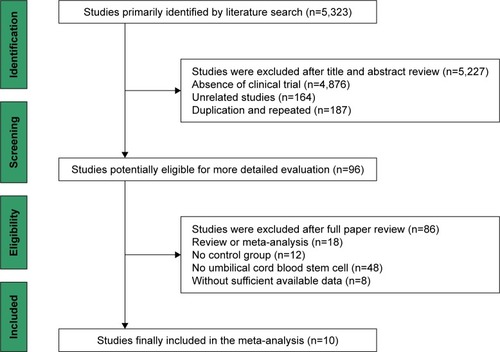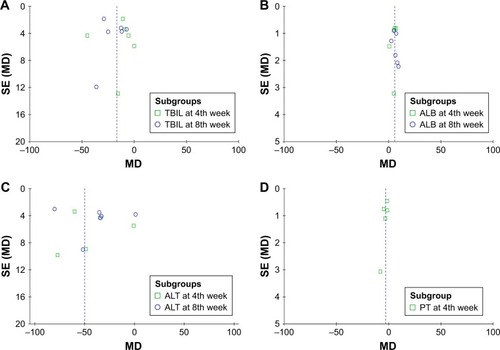Abstract
Objective
The aim of the study was to evaluate the efficacy and safety of umbilical cord blood stem cells (USCs) transplantation combined with routine supportive therapy (RST) for liver cirrhosis (LC).
Materials and methods
Clinical trials involved in this research were searched from Web of Science, PubMed, EMBASE, Cochrane Library, Wanfang and CNKI database. Treatment effects, quality of life (QoL), adverse events and other outcome measures were extracted and evaluated.
Results
A total of 10 trials including 616 LC patients were involved in this study. Based on our analysis, the liver function of LC patients was significantly improved after USCs transplantation and RST combined therapy, indicated by decreased total bilirubin, alanine aminotransferase, aspartate aminotransferase levels and prothrombin time and increased serum albumin level and prothrombin activity. Compared to those treated by RST alone, patients treated by combined therapy showed more satisfied treatment effects, improved QoL reflected by improved appetite (odds ratio [OR]=5.43, 95% CI=2.84 to 10.38, P<0.00001) and relieved fatigue (OR=4.33, 95% CI=0.87 to 21.60, P=0.07), ascetic fluid (OR=4.56, 95% CI=2.69 to 7.74, P<0.00001), abdominal distension (OR=4.01, 95% CI=1.34 to 12.02, P=0.01) and edema (OR=2.69, 95% CI=0.23 to 31.72, P=0.43). No serious adverse events occurred during USCs therapy.
Conclusion
USCs transplantation is a safe and effective adjuvant therapy for RST-treated LC, possibly through improving patients’ liver function.
Introduction
Liver cirrhosis (LC) is a common chronic progressive liver disease with diffuse liver damage, which usually results from prolonged or repeated alcohol excess, viral hepatitis and other etiologies.Citation1,Citation2 LC is characterized as reduced liver regeneration and hepatic dysfunction, which can lead to portal hypertension with serious complications including ascites, hepatic encephalopathy, secondary infection and so on.Citation3,Citation4 Incidence of LC and mortality caused by LC had risen remarkably in the past few decades, and the patients were usually diagnosed at the irreversible state.Citation1 Although survival has been improved due to effective LC management, it still ranks high among the world’s leading causes of death.Citation2,Citation5 Liver transplantation is the only curative treatment for patients with decompensated LC,Citation5 but it confronts with problems such as donor shortage, high medical costs, surgical complications, immunological rejection and ethical restraints.Citation3,Citation5 Liver transplantation failure may cause extensive and progressive fibrosis, which restrains liver regeneration and causes irreversible cirrhosis.Citation3
Researchers have been exploring new approaches to promote liver regeneration,Citation3 and stem cell therapy was considered as a promising treatment strategy.Citation6,Citation7 Preclinical LC studies on stem cell transplantation have shown beneficial effects, and the most commonly used cells were mesenchymal stem cells (MSCs),Citation8–Citation10 hepatic progenitor cells (HPCs)Citation11,Citation12 and hematopoietic stem cells (HSCs),Citation13,Citation14 which were usually obtained from autologous or allogeneic bone marrow.Citation4,Citation12 However, the procedure of bone marrow aspiration was invasive, and quantity and quality of bone marrow stem cells (BMSCs) are age-dependent, which limit their clinical potentiality.Citation15–Citation18 As an alternative source of BMSCs, umbilical cord blood stem cells (USCs) showed promising clinical application prospects. USCs are composed of immature immune cells and multipotent stem cells such as MSCs, endothelial progenitor cells (EPCs) and HSCs.Citation16,Citation17 They can migrate to injury sites due to chemotaxis, differentiate into various types of cells such as osteoblasts, chondrocytes and hepatocytes cells and secrete various cytokines and growth factors.Citation19 Compared to BMSCs, USCs are more accessible with fewer ethical constraints.Citation17,Citation18,Citation20
Clinical trials reported that USCs transfusion could ameliorate liver fibrosis and improve liver functions without significant side effects.Citation21,Citation22 In comparison with LC patients treated by routine supportive therapy (RST), those who underwent RST and USCs combined therapy exhibited more prominent therapeutic effects. In this study, we conducted a meta-analysis to systematically evaluate the therapeutic efficacy and safety of USCs and RST combined therapy in comparison with RST alone for LC, in order to provide scientific basis for future research and clinical application.
Materials and methods
Search strategy and selection criteria
We performed literature search across Web of Science, PubMed, EMBASE, Cochrane Library, Wanfang and CNKI database with key terms “stem cells” OR “umbilical cord blood stem cells”, AND “liver cirrhosis” OR “hepatocirrhosis”, without language restriction. Literature studies published before April 2017 were involved in this analysis.
The selection criteria are listed as follows: case-controlled trials involving >30 LC patients; participants diagnosed with LC, without malignant tumor and not pregnant or lactating; patients in the experimental group who received USCs and RST combined therapy, and those in the control group who were treated by RST alone.
Data extraction and quality assessment
Two authors (Huimin Tao and Yafeng Li) collected and summarized data independently, including author’s names, years of publication, locations, patients’ ages and LC stages, samples sizes, causes of LC, therapeutic regimens, administration routes, number of USCs and study parameter types. Trials’ quality was evaluated by following the instructions of Cochrane Handbook.Citation23
Outcome definition
Clinical responses evaluated in this research included treatment efficacy, quality of life (QoL) and adverse events. Treatment efficacy was assessed in terms of levels of total bilirubin (TBIL), serum albumin (ALB), alanine aminotransferase (ALT), aspartate aminotransferase (AST), prothrombin time (PT), prothrombin activity (PTA) and Child–Pugh score. Patients’ QoL covered the following indicators: fatigue, appetite, abdominal distension, ascitic fluid and edema.
Statistical analysis
We performed analysis using Review Manager 5.2 (Cochrane Collaboration). P<0.05 indicates differences with statistical significance. Appropriate analysis model was determined by heterogeneity according to Cochran’s Q test.Citation24 Studies with I2<50% or P>0.1 was considered homogenous, and fixed-effects model was applied; otherwise a random-effects model was applied.Citation25 Therapeutic efficacy was evaluated by odds ratio (OR) and presented with 95% CI.
Publication bias was evaluated based on the funnel plot. Sensitivity analyses were also performed to assess the impact of number of infused cells (>1×108 or <1×108) and routes of cell administration (intravenous or hepatic artery infusion).
Results
Search results
A total of 5,323 articles were initially identified, and 5,227 were excluded due to the lack of clinical trials (n=4,876), duplication and repetition (n=187) or were unrelated studies (n=164). After full-text assessment, 18 reviews or meta-analyses, 12 articles without control group, 48 studies without USCs transplantation and 8 with insufficient data were also excluded. After selection, 10 trialsCitation26–Citation35 with 616 LC patients were included in this meta-analysis ().
Characteristics of patients
All trials that met our selection criteria were conducted in People’s Republic of China. In total, 327 LC patients accepted USCs and RST combined therapy, and 289 patients were treated by RST alone.
USCs were obtained from healthy full-term infant’s umbilical cord blood and were infused to LC patients through hepatic artery (n=6), portal vein (n=1) or peripheral vein (n=3), respectively. Detailed information of the involved studies and participants is summarized in and .
Table 1 Clinical information from the eligible trials in the meta-analysis
Table 2 Information of USCs therapy
Quality assessment
Risk of bias assessment is shown in . Six studies had low risk and the other 4 studies did not have clear description of randomization process. All studies had low risk of bias on allocation, performance and detection. One trial missing follow-up study and 1 trial missing primary outcome data had high risk of bias, and 2 studies with selective reporting had unclear risk of bias.
Figure 2 (A) Risk of bias summary: review of authors’ judgments about each risk of bias item for the included studies. (B) Risk of bias graph: review of authors’ judgments about each risk of bias item presented as percentages across all the included studies. Each color represents a different level of bias: red for high risk, green for low risk and yellow for unclear risk of bias.
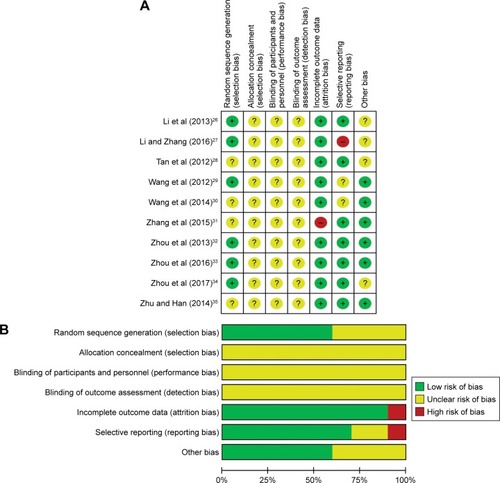
Therapeutic efficacy assessments
Random-effects meta-analysis was used to analyze the OR rate of the following descriptive indicators because of their high heterogeneity.
Effectiveness of USCs on TBIL, ALB, ALT, AST and coagulation function
As shown in , the TBIL level was reduced after combined therapy. This reduction was statistically significant in the 4th and 8th week (4th: OR=−14.37, CI=−26.15 to −2.58, P=0.02; 8th: OR=−18.92, CI=−27.74 to −10.10, P<0.0001), but not in the 1st, 12th and 24th week after treatment (1st: OR=−2.76, CI=−7.53 to 2.00, P=0.26; 12th: OR=−23.21, CI=−50.11 to 3.68, P=0.09; 24th: OR=−22.48, CI=−52.22 to 7.26, P=0.14). No statistical differences were observed in the TBIL level between experimental and control groups (Figure S1A).
Figure 3 Forest plot of the comparison of TBIL (A), ALB (B), ALT (C), AST (D), PT (E) and PTA (F) in pre- and post-therapy.
Abbreviations: IV, inverse variance method; TBIL, total bilirubin; ALB, albumin; ALT, alanine aminotransferase; AST, aspartate aminotransferase; PT, prothrombin time; PTA, prothrombin activity.
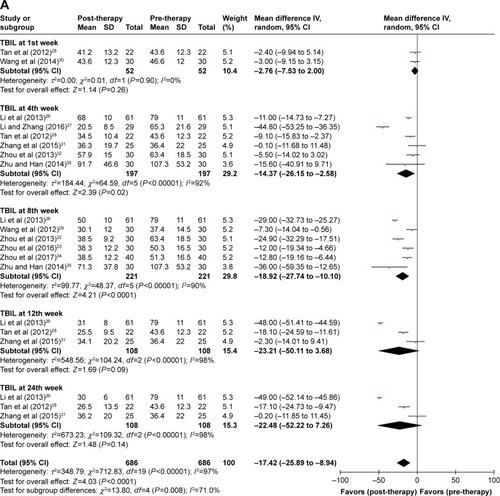
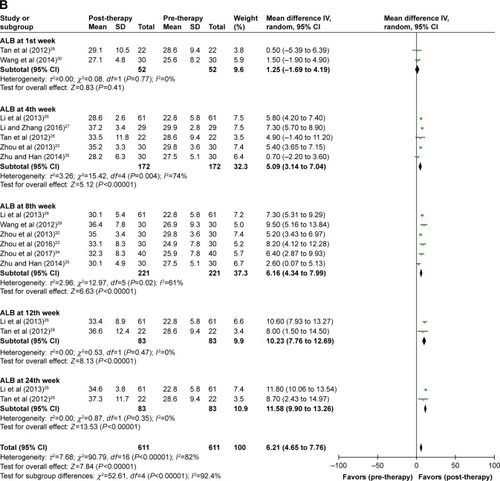
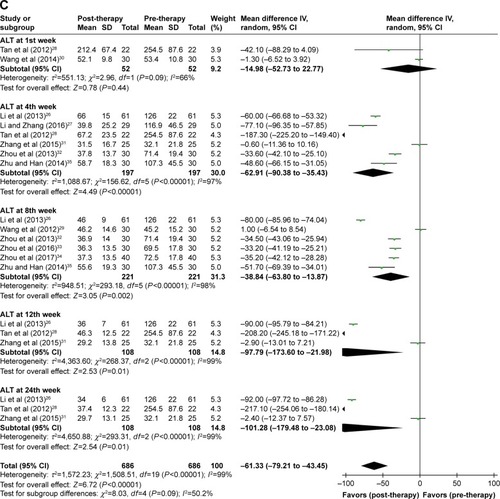

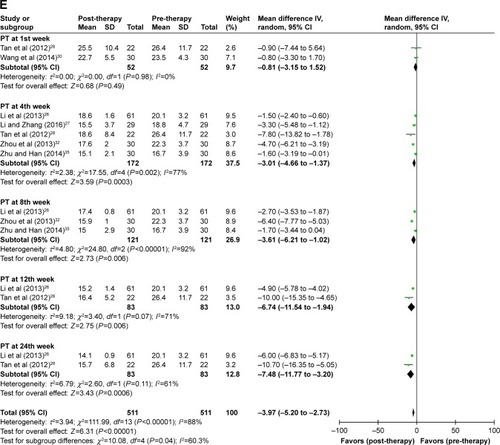
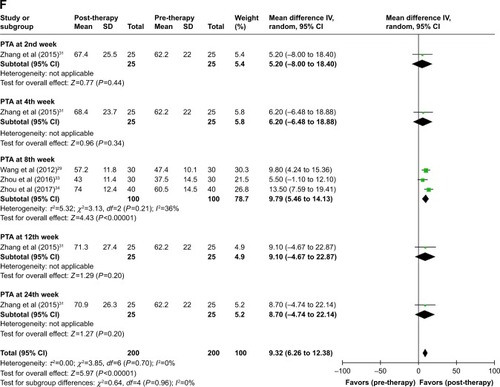
The ALB level was increased after combined therapy, especially in the 4th, 8th, 12th and 24th week (, 1st: OR=1.25, CI=−1.69 to 4.19, P=0.41; 4th: OR=5.09, CI=3.14 to 7.04, P<0.00001; 8th: OR=6.16, CI=4.34 to 7.99, P<0.00001; 12th: OR=10.23, CI=7.76 to 12.69, P<0.00001; 24th: OR=11.58, CI=9.90 to 13.26, P<0.00001). The ALB level in the combined therapy group was also higher than that of the control group in the 4th, 8th, 12th and 24th week after therapy (Figure S1B).
After combined therapy, the ALT level was significantly reduced in the 4th and 8th week (, 1st: OR=−14.98, CI=−52.73 to 22.77, P=0.44; 4th: OR=−62.91, CI=−90.38 to −35.43, P<0.00001; 8th: OR=−38.84, CI=−63.80 to −13.87, P=0.002; 12th: OR=−97.79, CI=−173.60 to −21.98, P=0.01; 24th: OR=−101.28, CI=−179.48 to −23.08, P=0.01). No statistical differences were observed in the ALT level between the 2 groups (Figure S1C).
As shown in , the AST level was significantly reduced only in the 8th week after combined therapy (1st: OR=−4.40, CI=−10.31 to 1.51, P=0.14; 4th: OR=−20.79, CI=−46.96 to 5.37, P=0.12; 8th: OR=−30.66, CI=−45.80 to −15.52, P<0.0001; 12th: OR=−3.40, CI=−13.69 to 6.89, P=0.52; 24th: OR=−1.80, CI=−12.24 to 8.64, P=0.74). Comparison between the 2 groups indicated that the AST level significantly decreased in the 8th week in the combined therapy group (Figure S1D).
The blood coagulation was evaluated in terms of PT and PTA. After combined therapy, PT was reduced in the 4th, 8th, 12th and 24th week (, 1st: OR=−0.81, CI=−3.15 to 1.52, P=0.49; 4th: OR=−3.01, CI=−4.66 to −1.37, P=0.0003; 8th: OR=−3.61, CI=−6.21 to −1.02, P=0.006; 12th: OR=−6.74, CI=−11.54 to −1.94, P=0.006; 24th: OR=−7.48, CI=−11.77 to −3.20, P=0.0006). Compared with patients treated by RST alone, shorter PT were observed in combined therapy-treated patients in the 8th, 12th and 24th week after treatment (Figure S1E).
As shown in , in the 8th week after combined therapy, PTA was statistically increased (2nd: OR=5.20, CI=−8.00 to 18.40, P=0.44; 4th: OR=6.20, CI=−6.48 to 18.88, P=0.34; 8th: OR=9.79, CI=5.46 to 14.13, P<0.00001; 12th: OR=9.10, CI=−4.67 to 22.87, P=0.20; 24th: OR=8.70, CI=−4.74 to 22.14, P=0.20). Meanwhile, the pooled results showed that in the 8th week after treatment, patients who underwent combined therapy had more significantly increased PTA compared with patients who received RST alone (Figure S1F).
All the abovementioned results indicated that the combination of USCs and RST had better therapeutic effects for LC patients than RST alone.
QoL assessment
QoL of patients who received combined therapy was significantly improved compared to those treated by RST alone, indicated by better appetite, relieved ascitic fluid and abdominal distension after USCs treatment (, appetite: OR=5.43, CI=2.84 to 10.38, P<0.00001; ascitic fluid: OR=4.56, CI=2.69 to 7.74, P<0.00001; abdominal distension: OR=4.01, CI=1.34 to 12.02, P=0.01), whereas the improvements in fatigue and edema were not significant (, fatigue: OR=4.33, CI=0.87 to 21.60, P=0.07; edema: OR=2.69, CI=0.23 to 31.72, P=0.43). Appetite and ascitic fluid were not heterogeneous among the studies, so the fixed-effects model was used for analyzing their OR. Otherwise, random-effects model was used.
Figure 4 Forest plot of the comparison of QoL including fatigue (A), appetite (B), abdominal distension (C), ascitic fluid (D) and edema (E) between the experimental and control groups.
Abbreviations: M–H, Mantel–Haenszel method; QoL, quality of life; USCs, umbilical cord blood stem cells; RST, routine supportive treatment.
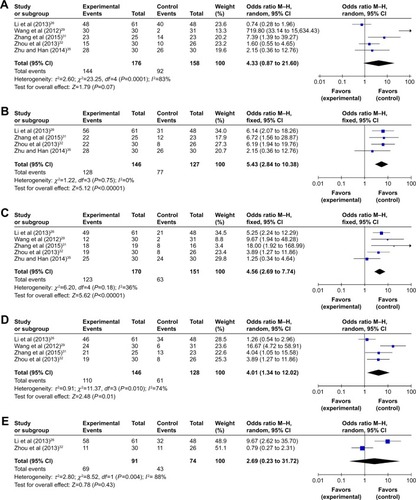
Adverse events assessment
We evaluated safety of USCs therapy in this meta-analysis. The most common side effect during treatment was fever, which usually subsided within 24 hours without treatment. No serious adverse events or death were reported after USCs therapy (). However, all trials did not compare the incidence of side effects in experimental and control groups.
Table 3 Information of adverse events during the USCs therapy
Publication bias
Funnel plots of TBIL, ALB, ALT and PT data were symmetrical in general, indicating small publication bias ( and S2).
Sensitivity analysis
Subgroup analyses were performed to evaluate the effects of cell numbers (>1×108 or <1×108) and administration routes (through intravenous or hepatic artery) on clinical efficacy. Results showed that a larger number of infused USCs (cell numbers >1×108) were associated with improved liver function, indicated by decreased TBIL and ALT levels and PT and increased ALB level ( and S1). Moreover, compared to intravenous USCs perfusion, USCs transplantation through hepatic artery was more effective in reducing the TBIL level and PT, but less valid in increasing the ALB level ( and S1).
Table 4 Subgroup analyses of TBIL, ALB, ALT and PT in pre- and post-therapy
Discussion
Stem cells derived from umbilical cord blood are mainly composed of HSCs, MSCs, EPCs and immature immunological cells.Citation16 HSCs and MSCs can differentiate into functional hepatocyte-like cells both in vitro and in vivo.Citation36,Citation37 Their anti-inflammatory and paracrine function can affect liver function.Citation5 MSCs can migrate and home to injured liver tissue,Citation38 differentiate into hepatocytes, inhibit hepatocytes death,Citation39 stimulate endogenous hepatocyte regeneration and promote the secretion of HGF, epidermal growth factor (EGF) and vascular endothelial growth factor (VEGF),Citation40 thereby enhance liver regeneration. van Poll et alCitation39 and Parekkadan et alCitation41 reported that MSCs can upregulate anti-inflammatory cytokine IL-10 and downregulate pro-inflammatory cytokines such as TNF-α and IL-6, by which they alleviate liver fibrosis. Moreover, MSCs can alleviate cirrhosis through inhibiting hepatic stellate cells’ proliferation, promoting their apoptosis and inhibiting extracellular matrix (ECM) accumulation.Citation3,Citation42,Citation43 Research of Higashiyama et alCitation44 indicated that MSCs can alleviate cirrhosis through expressing matrix metalloproteinase-2 (MMP-2) and MMP-9, which had antifibrotic effect by degrading the ECM. Pan et alCitation45 demonstrated that MSCs can attenuate liver fibrosis by specifically downregulating Dlk-1 expression through FGF2 secretion. Chen et alCitation46 found that MSCs remarkably inhibited the proliferation of hepatic stellate cells through activation of Notch and PI3K/Akt signaling pathways. EPCs have potential to regenerate the vascular endothelium in liver.Citation5,Citation47 Therefore, USCs were considered with promising prospective to treat LC.
In recent years, several studies have shown that USCs were safe and feasible treatment for LC. However, the different clinical protocols among those studies may lead to different therapeutic effects. In this study, we investigated published clinical trials extensively to achieve high statistical reliability. Our meta-analysis revealed that compared to LC patients who received RST alone, those treated by USCs and RST combined therapy exhibited more favorable efficacy, including increased ALB and PTA levels, and decreased TBIL, ALT, AST levels and PT, although changes in TBIL and ALT levels did not show statistical significance. Patients’ QoL was remarkably improved after USCs therapy, including improved appetite and relieved fatigue, abdominal distension, ascitic fluid and edema. These results indicated that the combination of USCs transplantation and RST had more satisfied therapeutic effects for LC patients than those treated by RST alone.
USCs have been clinically applied to treat hematological malignancies for more than 2 decades with a good safety record. In this research, our analyses showed that USCs were also safe to treat LC. Fever was the most common side effect during USCs therapy, which in most cases resolved naturally, and no serious adverse events or death occurred during therapy.
Some factors may influence the therapeutic effects of USCs therapy, such as USCs dosages and infusion routes. Number of infused USCs is one of the primary determinations in therapeutic strategy optimization. Nakamura et al found that human CD34+ cell transplantation after chronic liver injury aroused functional regeneration in a dose-dependent manner.Citation48 Our analysis also revealed that a larger number of infused USCs were associated with more satisfied efficacy. Moreover, we found that USCs infusion through hepatic artery was more effective in reducing TBIL and PT but not in increasing ALB compared to intravenous perfusion. However, currently available publications probing the impact of administration routes on USCs’ curative effect are still insufficient, and more data will be needed to perform convincible statistical analysis. We expect our study will be valuable for the design of upcoming comprehensive clinical trials.
Our study has some limitations. The numbers of LC patients included in this study was not big enough and the follow up periods was short. Although the effectiveness of USCs therapy on hematological, nerve and other system diseases have been reported,Citation49–Citation52 but its application on LC was still mainly performed in People’s Republic of China. This may be because there are a large number of Chinese LC patients and many Chinese research studies were focused on it, therefore abundant papers were generated. Moreover, the therapeutic effects of USCs therapy are affected by multiple factors, such as injection modes, infused USCs numbers and LC stages. Further detailed analyses need to be conducted based on research studies with sufficient information, standardized therapeutic regimens and strict patients inclusion criteria. Although the therapeutic effects of USCs for LC were satisfied, which population of cells among USCs was mainly responsible for these effects was unclear, and the underlying mechanism remained elusive. Qi et alCitation5 assumed that the improved liver microenvironments and/or the increased hepatocytes number may help liver function recovery after stem cell therapy.
Conclusion
This study confirmed the efficacy and safety of USCs transplantation and RST combined therapy for LC patients. USCs therapy greatly enhanced the improvement in liver function after RST and improved QoL of LC patients. Therefore, USCs transplantation and RST combined therapy is a promising treatment option for LC patients.
Author contributions
All authors contributed toward data analysis, drafting and critically revising the paper and agree to be accountable for all aspects of the work.
Acknowledgments
Huimin Tao and Yafeng Li are the co-first authors.
Supplementary materials
Figure S1 Forest plot of the comparison of TBIL (A), ALB (B), ALT (C), AST (D), PT (E) and PTA (F) between the experimental and control groups.
Notes: Control group, RST alone group; experimental group, RST plus USCs therapy.
Abbreviations: IV, inverse variance method; TBIL, total bilirubin; ALB, albumin; ALT, alanine aminotransferase; AST, aspartate aminotransferase; PT, prothrombin time; PTA, prothrombin activity; USCs, umbilical cord blood stem cells; RST, routine supportive treatment.
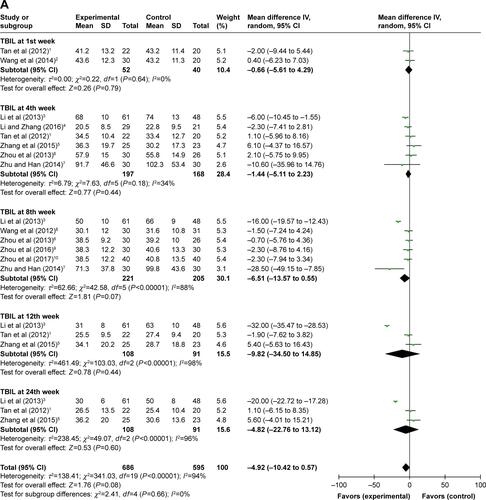
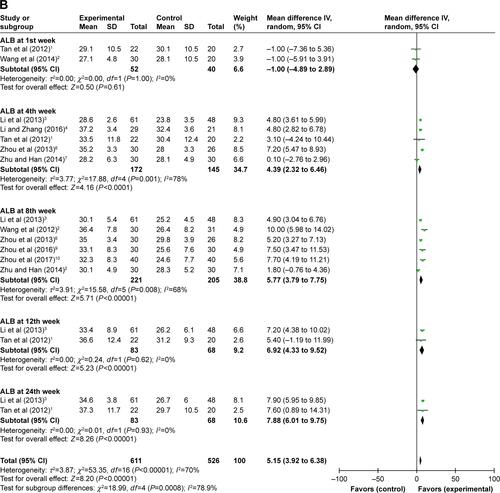
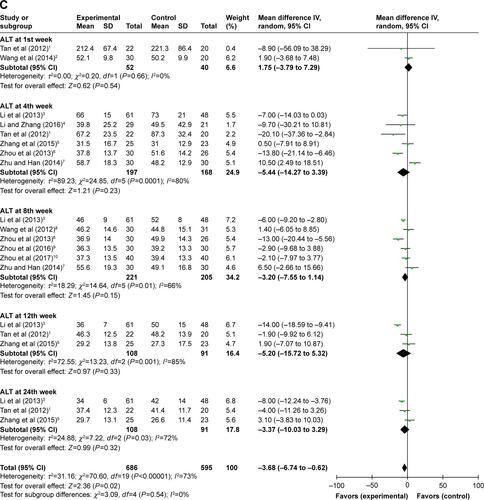
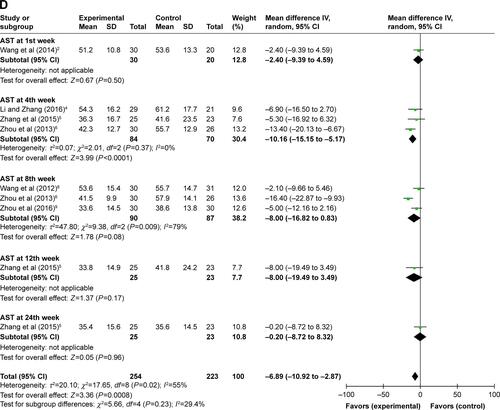
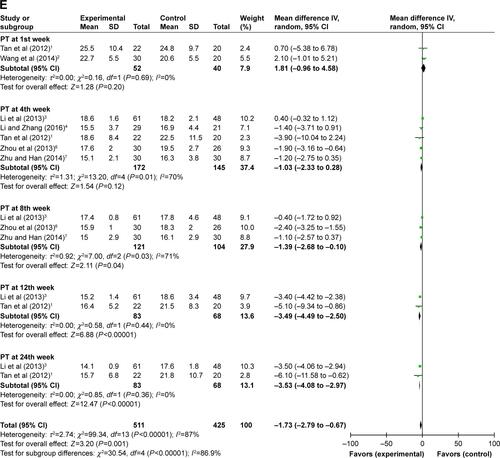
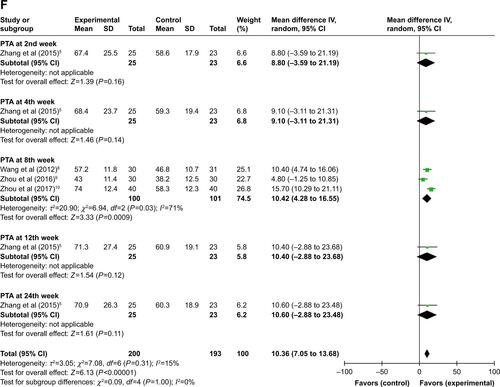
Figure S2 Funnel plot of percentage of total bilirubin (TBIL, A), albumin (ALB, B), alanine aminotransferase (ALT, C) and prothrombin time (PT, D) between the experimental and control groups.
Notes: Subgroup analyses were conducted in parameters discussed in >6 papers. Control group, routine supportive therapy alone group; experimental group, RST plus umbilical cord blood stem cell therapy.
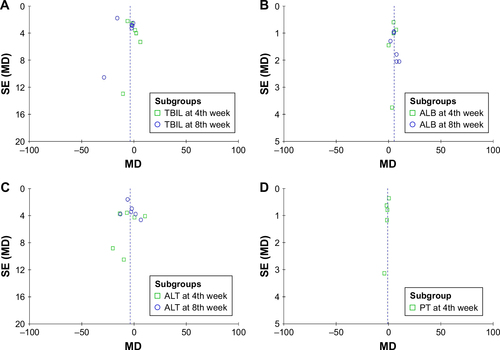
Table S1 Subgroup analyses of TBIL, ALB, ALT and PT between the experimental and control groups
References
- TanYWChenLZhuMQZhouXBMaoJZLiLDThe effect of transplantation of human umbilical cord blood stem cell on decompensated cirrhosisChin Hepatol201217542545
- WangKJLuoXHSunHTWangFBaoJTEffect of liver volume and liver hemodynamics of human umbilical cord blood stem cell transplantation on decompensated cirrhosisChin J Difficult Complicated Cases20141311261133
- LiWGCaiJLZhangJLEfficacy of umbilical cord blood stem cells in treatment of decompensated hepatitis B cirrhosisChin J Prac Med201340112114
- LiYYZhangDFA feasibility study on treating cirrhosis of hepatolenticular degeneration type by umbilical blood stem cell transplantation plus the Danhong injectionClin J Chin Med201682022
- ZhangSYanBYTongLXTherapeutic effect of the umbilical blood stem cell transplantation on the treatment of hepatitis B liver cirrhosisJ Prac Med20153131623165
- ZhouXLXieSHouQKLiCClinical research on umbilical cord blood stem cells transplantation for hepatitis B liver cirrhosis at discompensation stageJ Chengdu Med Coll20138571574
- ZhuYHHanDZClinical observation of the effect of umbilical cord blood stem cell transplantation in treatment of decompensated cirrhosisChin J Postgraduates Med2014371517
- WangFZhangJFengSXSongHTUmbilical cord blood stem cell transplantation via the portal vein: analysis of the curative rate in 30 patients with decompensated liver cirrhosisJ Clin Hepatol201228824827
- ZhouXRWangFYunSHIntrahepatic transplantation of umbilical cord blood stem cells in treatment of patients with decompensated primary biliary cirrhosisJ Prac Hepatol201619219220
- ZhouXRWangFYunSHTransplantation of human umbilical cord blood stem cells in treatment of patients with decompensated alcoholic liver cirrhosisJ Prac Hepatol201720232233
Disclosure
The authors report no conflicts of interest in this work.
References
- IrfanAAhmedICould stem cell therapy be the cure in liver cirrhosis?J Clin Exp Hepatol20155214214626155042
- ThanNNTomlinsonCLHaldarDKingALMooreDNewsomePNClinical effectiveness of cell therapies in patients with chronic liver disease and acute-on-chronic liver failure: a systematic review protocolSyst Rev2016510027301957
- MaXRTangYLXuanMChangZWangXYLiangXHTransplantation of autologous mesenchymal stem cells for end-stage liver cirrhosis: a meta-analysis based on seven controlled trialsGastroenterol Res Pract20152015110
- PanXNZhengLQLaiXHBone marrow-derived mesenchymal stem cell therapy for decompensated liver cirrhosis: a meta-analysisWorld J Gastroenterol20142038140511405725320545
- QiXGuoXSuCClinical outcomes of the transplantation of stem cells from various human tissue sources in the management of liver cirrhosis: a systematic review and meta-analysisCurr Stem Cell Res Ther201510216618025391380
- ZhangZWangFSStem cell therapies for liver failure and cirrhosisJ Hepatol20135918318523353868
- ShaoCHChenSLDongTFTransplantation of bone marrow-derived mesenchymal stem cells after regional hepatic irradiation ameliorates thioacetamide-induced liver fibrosis in ratsJ Surg Res2014186140841624071025
- SalamaHZekriARMedhatEPeripheral vein infusion of autologous mesenchymal stem cells in Egyptian HCV-positive patients with end-stage liver diseaseStem Cell Res Ther2014537024886681
- JangYOKimYJBaikSKHistological improvement following administration of autologous bone marrow-derived mesenchymal stem cells for alcoholic cirrhosis: a pilot studyLiver Int2014341334123782511
- MohamadnejadMAlimoghaddamKBagheriMRandomized placebo-controlled trial of mesenchymal stem cell transplantation in decompensated cirrhosisLiver Int201333101490149623763455
- KakinumaSTanakaYChinzeiRHuman umbilical cord blood as a source of transplantable hepatic progenitor cellsStem Cells200321221722712634418
- AndreonePCataniLMarginiCReinfusion of highly purified CD133+ bone marrow-derived stem/progenitor cells in patients with end-stage liver disease: a phase I clinical trialDig Liver Dis201547121059106626427587
- BurganovaGREffectiveness of autologous hematopoietic stem cells transplantation in patients with liver cirrhosisEksp Klin Gastroenterol201249197 Russian
- MohamadnejadMNamiriMBagheriMPhase 1 human trial of autologous bone marrow-hematopoietic stem cell transplantation in patients with decompensated cirrhosisWorld J Gastroenterol200713243359336317659676
- ZhouCYangBTianYImmunomodulatory effect of human umbilical cord Wharton’s jelly-derived mesenchymal stem cells on lymphocytesCell Immunol20112721333822004796
- WombleTAGreenSShahaduzzamanMMonocytes are essential for the neuroprotective effect of human cord blood cells following middle cerebral artery occlusion in ratMol Cell Neurosci201459768424472845
- HuangLLiuYLuJCerqueiraBMisraVDuongTQIntraarterial transplantation of human umbilical cord blood mononuclear cells in hyperacute stroke improves vascular functionStem Cell Res Ther2017817428330501
- SuganoMYoshidaHKurobeHEffects of transplanted human cord blood-mononuclear cells on pulmonary hypertension in immunodeficient mice and their distributionJ Med Invest2017641.2434928373627
- KumarAPrasadMJaliVPBone marrow mononuclear cell therapy in ischaemic stroke: a systematic reviewActa Neurol Scand2017135549650627558274
- LouXZhaoCChenHUnrelated donor umbilical cord blood transplant versus unrelated hematopoietic stem cell transplant in patients with acute leukemia: a meta-analysis and systematic reviewBlood Rev Epub20171115
- LinHZhangZShiMProspective controlled trial of safety of human umbilical cord derived-mesenchymal stem cell transplantation in patients with decompensated liver cirrhosisZhonghua Gan Zang Bing Za Zhi20122048749123044231
- ZhangZLinHShiMHuman umbilical cord mesenchymal stem cells improve liver function and ascites in decompensated liver cirrhosis patientsJ Gastroenterol Hepatol201227suppl 211212022320928
- ZengXZhangYKwongJSThe methodological quality assessment tools for preclinical and clinical studies, systematic review and meta-analysis, and clinical practice guideline: a systematic reviewJ Evid Based Med20158121025594108
- JacksonDWhiteIRRileyRDQuantifying the impact of between-study heterogeneity in multivariate meta-analysesStat Med201231293805382022763950
- DerSimonianRLairdNMeta-analysis in clinical trialsControl Clin Trials1986731771883802833
- LiWGCaiJLZhangJLEfficacy of umbilical cord blood stem cells in treatment of decompensated hepatitis B cirrhosisChin J Prac Med201340112114
- LiYYZhangDFA feasibility study on treating cirrhosis of hepatolenticular degeneration type by umbilical blood stem cell transplantation plus the Danhong injectionClin J Chin Med201682022
- TanYWChenLZhuMQZhouXBMaoJZLiLDThe effect of transplantation of human umbilical cord blood stem cell on decompensated cirrhosisChin Hepatol201217542545
- WangFZhangJFengSXSongHTUmbilical cord blood stem cell transplantation via the portal vein: analysis of the curative rate in 30 patients with decompensated liver cirrhosisJ Clin Hepatol201228824827
- WangKJLuoXHSunHTWangFBaoJTEffect of liver volume and liver hemodynamics of human umbilical cord blood stem cell transplantation on decompensated cirrhosisChin J Difficult Complicated Cases20141311261133
- ZhangSYanBYTongLXTherapeutic effect of the umbilical blood stem cell transplantation on the treatment of hepatitis B liver cirrhosisJ Prac Med20153131623165
- ZhouXLXieSHouQKLiCClinical research on umbilical cord blood stem cells transplantation for hepatitis B liver cirrhosis at discompensation stageJ Chengdu Med Coll20138571574
- ZhouXRWangFYunSHIntrahepatic transplantation of umbilical cord blood stem cells in treatment of patients with decompensated primary biliary cirrhosisJ Prac Hepatol201619219220
- ZhouXRWangFYunSHTransplantation of human umbilical cord blood stem cells in treatment of patients with decompensated alcoholic liver cirrhosisJ Prac Hepatol201720232233
- ZhuYHHanDZClinical observation of the effect of umbilical cord blood stem cell transplantation in treatment of decompensated cirrhosisChin J Postgraduates Med2014371517
- YinLZhuYYangJAdipose tissue-derived mesenchymal stem cells differentiated into hepatocyte-like cells in vivo and in vitroMol Med Rep20151131722173225395242
- Al GhrbawyNMAfifyRADyaaNEl SayedAADifferentiation of bone marrow: derived mesenchymal stem cells into hepatocyte-like cellsIndian J Hematol Blood Transfus201632327628327429519
- ChoKAJuSYChoSJMesenchymal stem cells showed the highest potential for the regeneration of injured liver tissue compared with other subpopulations of the bone marrowCell Biol Int200933777277719427913
- van PollDParekkadanBChoCHMesenchymal stem cell-derived molecules directly modulate hepatocellular death and regeneration in vitro and in vivoHepatology20084751634164318395843
- AdasGKocBAdasMEffects of mesenchymal stem cells and VEGF on liver regeneration following major resectionLangenbeck Arch Surg20164015725740
- ParekkadanBvan PollDMegeedZImmunomodulation of activated hepatic stellate cells by mesenchymal stem cellsBiochem Biophys Res Commun2007363224725217869217
- ZhangBInagakiMJiangBEffects of bone marrow and hepatocyte transplantation on liver injuryJ Surg Res20091571718019345373
- ChangYJLiuJWLinPCMesenchymal stem cells facilitate recovery from chemically induced liver damage and decrease liver fibrosisLife Sci20098513–1451752519686763
- HigashiyamaRInagakiYHongYYBone marrow-derived cells express matrix metalloproteinases and contribute to regression of liver fibrosis in miceHepatology200745121322217187438
- PanRLWangPXiangLXShaoJZDelta-like 1 serves as a new target and contributor to liver fibrosis down-regulated by mesenchymal stem cell transplantationJ Biol Chem201128614123401234821239501
- ChenSXuLLinNPanWHuKXuRActivation of Notch1 signaling by marrow-derived mesenchymal stem cells through cell-cell contact inhibits proliferation of hepatic stellate cellsLife Sci20118925–2697598122056375
- MoonYJYoonHHLeeMWMultipotent progenitor cells derived from human umbilical cord blood can differentiate into hepatocyte-like cells in a liver injury rat modelTransplant Proc200941104357436020005398
- NakamuraTTsutsumiVTorimuraTHuman peripheral blood CD34-positive cells enhance therapeutic regeneration of chronically injured liver in nude ratsJ Cell Physiol201222741538155221678408
- RochaVUmbilical cord blood cells from unrelated donor as an alternative source of hematopoietic stem cells for transplantation in children and adultsSemin Hematol201653423724527788761
- PinanaJLSanzJEsquirolAUmbilical cord blood transplantation in adults with advanced Hodgkin’s disease: high incidence of post-transplant lymphoproliferative diseaseEur J Haematol201696212813525845981
- KangMMinKJangJInvolvement of immune responses in the efficacy of cord blood cell therapy for cerebral palsyStem Cells Dev201524192259226825977995
- KongDZhuangXWangDUmbilical cord mesenchymal stem cell transfusion ameliorated hyperglycemia in patients with type 2 diabetes mellitusClin Lab201460121969197625651730

